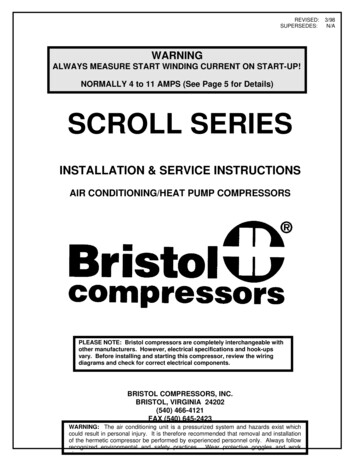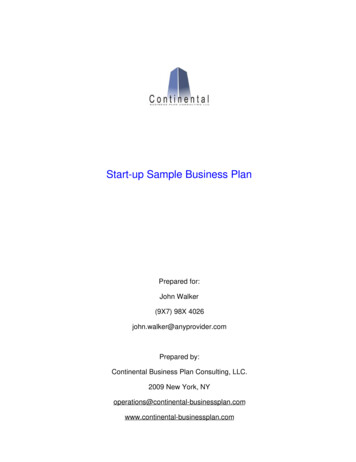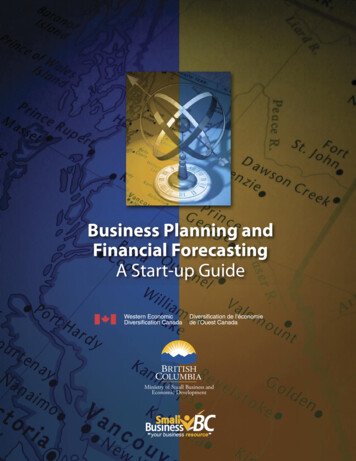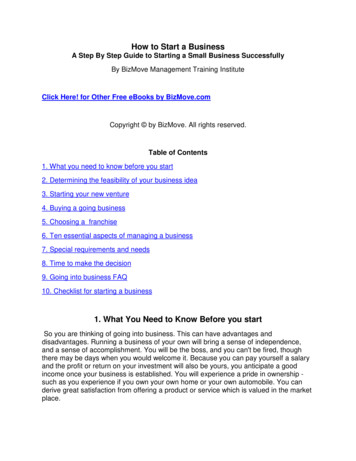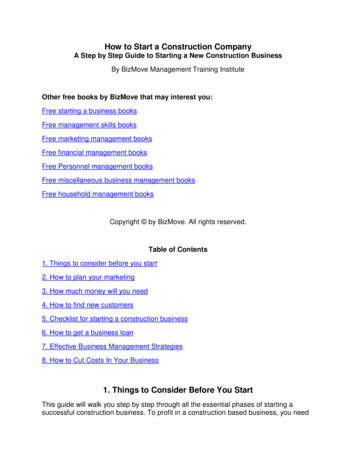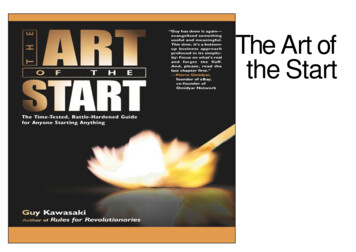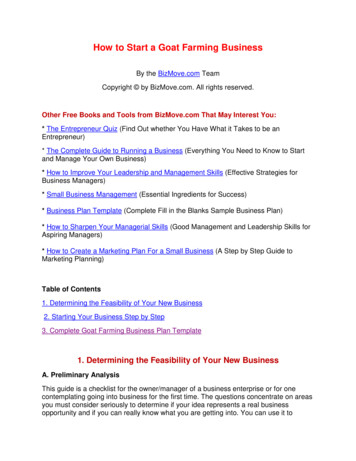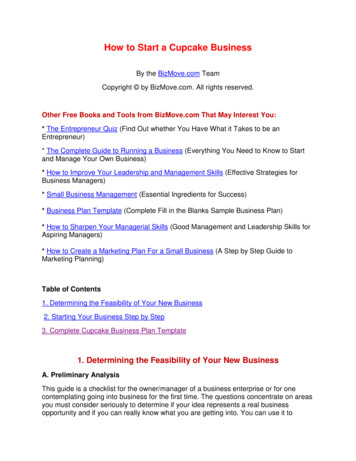
Transcription
How to Start a Cupcake BusinessBy the BizMove.com TeamCopyright by BizMove.com. All rights reserved.Other Free Books and Tools from BizMove.com That May Interest You:* The Entrepreneur Quiz (Find Out whether You Have What it Takes to be anEntrepreneur)* The Complete Guide to Running a Business (Everything You Need to Know to Startand Manage Your Own Business)* How to Improve Your Leadership and Management Skills (Effective Strategies forBusiness Managers)* Small Business Management (Essential Ingredients for Success)* Business Plan Template (Complete Fill in the Blanks Sample Business Plan)* How to Sharpen Your Managerial Skills (Good Management and Leadership Skills forAspiring Managers)* How to Create a Marketing Plan For a Small Business (A Step by Step Guide toMarketing Planning)Table of Contents1. Determining the Feasibility of Your New Business2. Starting Your Business Step by Step3. Complete Cupcake Business Plan Template1. Determining the Feasibility of Your New BusinessA. Preliminary AnalysisThis guide is a checklist for the owner/manager of a business enterprise or for onecontemplating going into business for the first time. The questions concentrate on areasyou must consider seriously to determine if your idea represents a real businessopportunity and if you can really know what you are getting into. You can use it to
evaluate a completely new venture proposal or an apparent opportunity in your existingbusiness.Perhaps the most crucial problem you will face after expressing an interest in starting anew business or capitalizing on an apparent opportunity in your existing business will bedetermining the feasibility of your idea. Getting into the right business at the right time issimple advice, but advice that is extremely difficult to implement. The high failure rate ofnew businesses and products indicates that very few ideas result in successful businessventures, even when introduced by well established firm. Too many entrepreneurs strikeout on a business venture so convinced of its merits that they fail to thoroughly evaluateits potential.This checklist should be useful to you in evaluating a business idea. It is designed tohelp you screen out ideas that are likely to fail before you invest extensive time, money,and effort in them.Preliminary AnalysisA feasibility study involves gathering, analyzing and evaluating information with thepurpose of answering the question: "Should I go into this business?" Answering thisquestion involves first a preliminary assessment of both personal and projectconsiderations.General Personal ConsiderationsThe first seven questions ask you to do a little introspection. Are your personalitycharacteristics such that you can both adapt to and enjoy businessownership/management?1. Do you like to make your own decisions?2. Do you enjoy competition?3. Do you have will power and self-discipline?4. Do you plan ahead?5. Do you get things done on time?6. Can you take advise from others?7. Are you adaptable to changing conditions?The next series of questions stress the physical, emotional, and financial strains of anew business.8. Do you understand that owning your own business may entail working 12 to 16hours a day, probably six days a week, and maybe on holidays?9. Do you have the physical stamina to handle a business?
10. Do you have the emotional strength to withstand the strain?11. Are you prepared to lower your standard of living for several months or years?12. Are you prepared to loose your savings?Specific Personal Considerations1. Do you know which skills and areas of expertise are critical to the success of yourproject?2. Do you have these skills?3. Does your idea effectively utilize your own skills and abilities?4. Can you find personnel that have the expertise you lack?5. Do you know why you are considering this project?6. Will your project effectively meet your career aspirationsThe next three questions emphasize the point that very few people can claim expertisein all phases of a feasibility study. You should realize your personal limitations and seekappropriate assistance where necessary (i.e. marketing, legal, financial).7. Do you have the ability to perform the feasibility study?8. Do you have the time to perform the feasibility study?9. Do you have the money to pay for the feasibility study done?General Project Description1. Briefly describe the business you want to enter.2. List the products and/or services you want to sell3. Describe who will use your products/services4. Why would someone buy your product/service?5. What kind of location do you need in terms of type of neighborhood, traffic count,nearby firms, etc.?
6. List your product/services suppliers.7. List your major competitors - those who sell or provide like products/services.8. List the labor and staff you require to provide your products/services.B. Requirements For SuccessTo determine whether your idea meets the basic requirements for a successful newproject, you must be able to answer at least one of the following questions with a "yes."1. Does the product/service/business serve a presently unserved need?2. Does the product/service/business serve an existing market in which demandexceeds supply?3. Can the product/service/business successfully compete with an existing competitionbecause of an "advantageous situation," such as better price, location, etc.?Major FlawsA "Yes" response to questions such as the following would indicate that the idea haslittle chance for success.1. Are there any causes (i.e., restrictions, monopolies, shortages) that make any of therequired factors of production unavailable (i.e., unreasonable cost, scare skills, energy,material, equipment, processes, technology, or personnel)?2. Are capital requirements for entry or continuing operations excessive?3. Is adequate financing hard to obtain?4. Are there potential detrimental environmental effects?5. Are there factors that prevent effective marketing?C. Desired Income
The following questions should remind you that you must seek both a return on yourinvestment in your own business as well as a reasonable salary for the time you spendin operating that business.1. How much income do you desire?2. Are you prepared to earn less income in the first 1-3 years?3. What minimum income do you require?4. What financial investment will be required for your business?5. How much could you earn by investing this money?6. How much could you earn by working for someone else?7. Add the amounts in 5 and 6. If this income is greater that what you can realisticallyexpect from your business, are you prepared to forego this additional income just to beyour own boss with the only prospects of more substantial profit/income in future years?8. What is the average return on investment for a business of your type?D. Preliminary Income StatementBesides return on investment, you need to know the income and expenses for yourbusiness. You show profit or loss and derive operating ratios on the income statement.Dollars are the (actual, estimated, or industry average) amounts for income andexpense categories. Operating ratios are expressed as percentages of net sales andshow relationships of expenses and net sales.For instance 50,000 in net sales equals 100% of sales income (revenue). Net profit aftertaxes equals 3.14% of net sales. The hypothetical "X" industry average after tax netprofit might be 5% in a given year for firms with 50,000 in net sales. First you estimateor forecast income (revenue) and expense dollars and ratios for your business. Thencompare your estimated or actual performance with your industry average. Analyze
differences to see why you are doing better or worse than the competition or why yourventure does or doesn't look like it will float.These basic financial statistics are generally available for most businesses from tradeand industry associations, government agencies, universities and private companiesand banksForecast your own income statement. Do not be influenced by industry figures. Yourestimates must be as accurate as possible or else you will have a false impression.1. What is the normal markup in this line of business. i.e., the dollar difference betweenthe cost of goods sold and sales, expressed as a percentage of sales?2. What is the average cost of goods sold percentage of sales?3. What is the average inventory turnover, i.e., the number of times the averageinventory is sold each year?4. What is the average gross profit as a percentage of sales?5. What are the average expenses as a percentage of sales?6. What is the average net profit as a percent of sales?7. Take the preceding figures and work backwards using a standard income statementformat and determine the level of sales necessary to support your desired income level.8. From an objective, practical standpoint, is this level of sales, expenses and profitattainable?
E. Market AnalysisThe primary objective of a market analysis is to arrive at a realistic projection of sales.after answering the following questions you will be in a better positions to answerquestion eight immediately above.Population1. Define the geographical areas from which you can realistically expect to drawcustomers.2. What is the population of these areas?3. What do you know about the population growth trend in these areas?4. What is the average family size?
5. What is the age distribution?6. What is the per capita income?7. What are the consumers' attitudes toward business like yours?8. What do you know about consumer shopping and spending patterns relative to yourtype ofbusiness?9. Is the price of your product/service especially important to your target market?10. Can you appeal to the entire market?11. If you appeal to only a market segment, is it large enough to be profitable?F. Competition1. Who are your major competitors?2. What are the major strengths of each?3. What are the major weaknesses of each?4. Are you familiar with the following factors concerning your competitors:Price structure?Product lines (quality, breadth, width)?
Location?Promotional activities?Sources of supply?Image from a consumer's viewpoint?5. Do you know of any new competitors?6. Do you know of any competitor's plans for expansion?7. Have any firms of your type gone out of business lately?8. If so, why?9. Do you know the sales and market share of each competitor?10. Do you know whether the sales and market share of each competitor areincreasing, decreasing, or stable?11. Do you know the profit levels of each competitor?12. Are your competitors' profits increasing, decreasing, or stable?13. Can you compete with your competition?
G. Sales1. Determine the total sales volume in your market area.2. How accurate do you think your forecast of total sales is?3. Did you base your forecast on concrete data?4. Is the estimated sales figure "normal" for your market area?5. Is the sales per square foot for your competitors above the normal average?6. Are there conditions, or trends, that could change your forecast of total sales?7. Do you expect to carry items in inventory from season to season, or do you plan tomark down products occasionally to eliminate inventories? If you do not carry overinventory, have you adequately considered the effect of mark-down in your pricing?(Your gross profits margin may be too low.)8. How do you plan to advertise and promote your product/service/business?9. Forecast the share of the total market that you can realistically expect - as a dollaramount and as a percentage of your market.10. Are you sure that you can create enough competitive advantages to achieve themarket share in your forecast of the previous question?11. Is your forecast of dollar sales greater than the sales amount needed to guaranteeyour desired or minimum income?
12. Have you been optimistic or pessimistic in your forecast of sales?13. Do you need to hire an expert to refine the sales forecast?14. Are you willing to hire an expert to refine the sales forecast?H. Supply1. Can you make a list of every item of inventory and operating supplies needed?2. Do you know the quantity, quality, technical specifications, and price ranges desired?3. Do you know the name and location of each potential source of supply?4. Do you know the price ranges available for each product from each supplier?5. Do you know about the delivery schedules for each supplier?6. Do you know the sales terms of each supplier?7. Do you know the credit terms of each supplier?8. Do you know the financial condition of each supplier?9. Is there a risk of shortage for any critical materials or merchandise?10. Are you aware of which supplies have an advantage relative to transportationcosts?11. Will the price available allow you to achieve an adequate markup?I. Expenses1. Do you know what your expenses will be for: rent, wages, insurance, utilities,advertising, interest, etc?2. Do you need to know which expenses are Direct, Indirect, or Fixed?3. Do you know how much your overhead will be?4. Do you know how much your selling expenses will be?Miscellaneous
1. Are you aware of the major risks associated with your product? Service Business?2. Can you minimize any of these major risks?3. Are there major risks beyond your control?4. Can these risks bankrupt you? (fatal flaws)J. Venture Feasibility1. Are there any major questions remaining about your proposed venture?2. Do the above questions arise because of a lack of data?3. Do the above questions arise because of a lack of management skills?4. Do the above questions arise because of a "fatal flaw" in your idea?5. Can you obtain the additional data needed?Go to Top2. Starting Your Business Step by StepThings to Consider Before You StartThis guide will walk you step by step through all the essential phases of starting asuccessful retail business. To profit in a retail business, you need to consider thefollowing questions: What business am I in? What goods do I sell? Where is mymarket? Who will buy? Who is my competition? What is my sales strategy? Whatmerchandising methods will I use? How much money is needed to operate my store?How will I get the work done? What management controls are needed? How can theybe carried out? Where can I go for help?As the owner, you have to answer these questions to draw up your business plan. Thepages of this Guide are a combination of text and suggested analysis so that you canorganize the information you gather from research to develop your plan, giving you aprogression from a common sense starting point to a profitable ending point.What Is a Business Plan?The success of your business depends largely upon the decisions you make. Abusiness plan allocates resources and measures the results of your actions, helping youset realistic goals and make logical decisions.You may be thinking, "Why should I spend my time drawing up a business plan? What'sin it for me?" If you've never worked out a plan, you are right in wanting to hear aboutthe possible benefits before you do the work. Remember first that the lack of planning
leaves you poorly equipped to anticipate future decisions and actions you must make ortake to run your business successfully. A business plan Gives you a path to follow. Aplan with goals and action steps allows you to guide your business through turbulentoften unforeseen economic conditions.A plan shows your banker the condition and direction of your business so that yourbusiness can be more favorably considered for a loan because of the banker's insightinto your situation.A plan can tell your sales personnel, suppliers, and others about your operations andgoals.A plan can help you develop as a manager. It can give you practice in thinking andfiguring out problems about competitive conditions, promotional opportunities andsituations that are good or bad for your business. Such practice over a period of timecan help increase an owner-manager's ability to make judgments.A second plan tells you what to do and how to do it to achieve the goals you have setfor your business.What Business Am I In?In making your business plan, the first question to consider is: What business am Ireally in? At first reading, this question may seem silly. "If there is one thing I know," yousay to yourself, "it is what business I'm in." Hold on and think. Some owner-managershave gone broke and others have wasted their savings because they did not define theirbusinesses in detail. Actually they were confused about what business they were in.Look at an example. Mr. Jet maintained a dock and sold and rented boats. He thoughthe was in the marina business. But when he got into trouble and asked for outside help,he learned that he was not necessarily in the marina business. He was in severalbusinesses. He was in the restaurant business with a dockside cafe, serving meals toboating parties. He was in the real estate business, buying and selling lots. He was inboat repair business, buying parts and hiring a mechanic as demand rose. Mr. Jet wastrying to be too many things and couldn't decide which venture to put money into andhow much return to expect. What slim resources he had were fragmented.Before he could make a profit on his sales and a return on his investment, Mr. Jet hadto decide what business he really was in and concentrate on it. After much study, herealized that he should stick to the marina format, buying, selling, and servicing boats.Decide what business you are in and write it down - define your business.To help you decide, think of answers to questions like: What do you buy? What do yousell? Which of your lines of goods yields the greatest profit? What do people ask youfor? What is it that you are trying to do better or more of or differently from yourcompetitors? Write it down in detail.Planning Your MarketingWhen you have decided what business you are in, you are ready to consider anotherimportant part of you business plan. Marketing. Successful marketing starts with theowner-manager. You have to know the merchandise you sell and the wishes and wants
of your customers you can appeal to. The objective is to move the stock off the shelvesand display racks at the right price and bring in sales dollars.The text and suggested working papers that follow are designed to help you work out amarketing plan for your store.Determining the Sales PotentialIn retail business, your sales potential depends on location. Like a tree, a store has todraw its nourishment from the area around it. The following questions should help youwork through the problem of selecting a profitable location.In what part of the city or town will you locate?In the downtown business section?In the area right next to the downtown business area?In a residential section of the town?On the highway outside of town?In the suburbs?In a suburban shopping center?On a worksheet, write where you plan to locate and give your reasons why you chosethat particular location.Now consider these questions that will help you narrow down a place in your locationarea.What is the competition in the area you have picked?How many of the stores look prosperous?How many look as though they are barely getting by?How many similar stores went out of business in this area last year?How many new stores opened up in the last year?What price line does competition carry?Which store or stores in the area will be your biggest competitors?Again, write down the reasons for your opinions. Also write out an analysis of the area'seconomic base and give the reason for your opinion. Is the area in which you plan tolocate supported by a strong economic base? For example, are nearby industriesworking full time? Only part time? Did any industries go out of business in the pastseveral months? Are new industries scheduled to open in the next several months?When you find a store building that seems to be what you need, answer the followingquestions:Is the neighborhood starting to get run down?Is the neighborhood new and on the way up? (The local Chamber of Commerce mayhave census data for your area. Census Tracts on Population, published by the Bureau
of Census, may be useful. Other sources on such marketing statistics are tradeassociations and directories).Are there any super highways or through-ways planned for the neighborhood?Is street traffic fairly heavy all day?How close is the building to bus lines and other transportation?Are there adequate parking spaces convenient to your store?Are the sidewalks in good repair (you may have to repair them)?is the street lighting good?Is your store on the sunny side of the street?What is the occupancy history of this store building? Does the store have a reputationfor failures? (Have stores opened and closed after a short time)?Why have other businesses failed in this location?What is the physical condition of the store?What service does the landlord provide?What are the terms of the lease?How much rent must you pay each month?Estimate the gross annual sales you expect in this location.When you think you have finally solved the site location question, ask your banker torecommend people who know most about location in your line of business. Contactthese people and listen to their advice and opinions, weigh what they say, then decide.How to Attract CustomersWhen you have a location in mind, you should work through another aspect ofmarketing. How will you attract customers to your store? How will you pull businessaway from your competition?It is in working with this aspect of marketing that many retailers find competitiveadvantages. The ideas that they develop are as good as and often better than thosethat large companies develop. The work blocks that follow are designed to help youthink about image, pricing, customer service policies, and advertising.ImageA store has an image whether or not the owner is aware of it. For example, throw somemerchandise onto shelves and onto display tables in a dirty, dimly lit store and you'vegot an image. Shoppers think of it as a dirty, junky store and avoid coming into it. Yourimage should be concrete enough to promote in your advertising and other promotionalactivities. For example, "home-cooked" food might be the image of a small restaurant.Write out on a worksheet the image that you want shoppers and customers to have ofyour store.
PricingValue received is the key to pricing. The only way a store can have low prices is to selllow-priced merchandise. Thus, what you do about the prices you charge depends onthe lines of merchandise you buy and sell. It depends also on what your competitioncharges for these lines of merchandise. Your answers to the following questions shouldhelp you to decide what to do about pricing.In what price ranges are your line of merchandise soldHigh , Medium , or Low ?Will you sell for cash only?What services will you offer to justify your prices if they are higher than yourcompetitor's prices?If you offer credit, will your price have to be higher than if all sales are for cash? Thecredit costs have to come from somewhere. Plan for them.If you use credit card systems, what will it cost you? Will you have to add to your pricesto absorb this cost.Customer Service PoliciesThe service you provide your customers may be free to them, but you pay for it. Forexample, if you provide free parking, you pay for your own parking lot or pick up yourpart of the cost of a lot you share with other retailers.Make a list of the services that your competitors offer and estimate the cost of eachservice. How many of these services will you have to provide just to be competitive? Arethere other services that would attract customers but that competitors are not offering?If so, what are your estimates of the cost of such services? Now list all the services youplan to offer and the estimated costs. Total this expense and figure out how you caninclude those added costs in your prices without pricing your merchandise out of themarket.Planning Your Advertising ActivitiesAdvertising was saved until the last because you have to have something to say beforeadvertising can be effective. When you have an image, price range, and customerservices, you are ready to tell prospective customers why they should shop in yourstore.When the money you can spend for advertising is limited, it is vital that your advertisingbe on target. Before you think about how much money you can afford for advertising,take time to determine what jobs you want to do for your store. List what makes yourstore different from your competitors. List the facts about your store and its merchandisethat your advertising should tell shoppers and prospective customers.When you have these facts listed and in hand, you are ready to think about the formyour advertising should take and its cost. Ask the local media (newspapers, radio andtelevision, and printers of direct mail pieces) for information about the services andresults they offer for your money.
How you spend advertising money is your decision, but don't fall into the trap thatsnares many advertisers who have little or no experience with advertising copy andmedia selection. Advertising is a profession. Don't spend a lot of money on advertisingwithout getting professional advice on what kind and how much advertising your storeneeds.The following work sheet can be useful in determining what advertising is needed to sellyour strong points to prospective customers.When you have a figure on what your advertising for the next twelve months will cost,check it against what similar stores spend. Advertising expense is one of the operatingratios (expenses as a percentage of sales) that trade associations and otherorganizations gather. If your estimated cost for advertising is substantially higher thanthis average for your line of merchandise, take a second look. No single expense itemshould be allowed to get way out of line if you want to make a profit. Your task indetermining how much to spend for advertising comes down to the question, "Howmuch can I afford to spend and still do the job that needs to be done?"In-store Sales PromotionTo complete your work on marketing, you need to think about what you want to happenafter prospects get inside your store. Your goal is to move stock off your shelves anddisplays at a profit and satisfy your customers. You want repeat customers and moneyin your cash register.At this point, if you have decided to sell for cash only, take a second look at yourdecision. Don't overlook the fact that Americans like to buy on credit. Often a creditcard, or other system of credit and collections, is needed to attract and hold customers.Customers will have more buying confidence and be more comfortable in your store ifthey know they can afford to buy. Credit makes this possible.To encourage people to buy, self-service stores rely on layout, attractive displays, signsand clearly marked prices on the items offered for sale. Other stores combine thesetechniques with personal selling.List the display counters, racks, special equipment (something peculiar to your businesslike a frozen food display bin or a machine to measure and cut cloth), and other fixtures.Figure the cost of all fixtures and equipment by listing them on a worksheet as follows:
Draw several layouts of your store and attach the layout that suits you to the costworksheet. Determine how many signs you may need for a twelve month operation andestimate that cost also.If your store is a combination of self-service and personal selling, how many salespersons and cashiers will you need? Estimate, I will need sales persons at each week (include payroll taxes and insurance in this salaries cost). In ayear, salaries will cost: .Personal attention to customers is one strong point that a store can use as acompetitive tool. You want to emphasize in training employees that everyone has topitch in and get the job done. Customers are not interested in job descriptions, but theyare interested in being served promptly and courteously. Nothing is more frustrating to acustomer than being ignored by an employee. Decide what training you will give yoursales people in the techniques of how to greet customers, show merchandise, suggestother items, and handle customer needs and complaints.BuyingWhen buying merchandise for resale, you need to answer questions such as:Who sells the line to retailers? Is it sold by the manufacturer directly or throughwholesalers and distributors?What delivery service can you get and must you pay shipping charges?What are the terms of buying?Can you get credit?How quickly can the vendor deliver fill-in orders?You should establish a source of supply on acceptable terms for each line ofmerchandise and estimate a plan for purchasing as follows:(1) How many days or weeks does it take the supplier to deliver the merchandise toyour store.(2) Who pays? You, the buyer? The supplier? Freight or transportation costs are a bigexpense item.
(3) What is the supplier's policy on fill-in orders? That is, do you have to buy a gross, adozen, or will the supplier ship only two or three items? How long does it take for thedelivery to get into your store?Stock ControlOften shoppers leave without buying because the store did not have the items theywanted or the sizes and colors were wrong. Stock control, combined with supplierswhose policies on fill-in orders are favorable to you, provides a way to reduce"walkouts".The type of system you use to keep informed about your stock, or inventory, dependson your line of merchandise and the delivery dates provided by your suppliers.Your stock control system should enable you to determine what needs to be ordered onthe basis of: (1) what is on hand, (2) what is on order, and (3) what has been sold.Some trade associations and suppliers provide systems to members and customers,otherwise your accountant can set up a system that is best for your business. Inventorycontrol is based upon either
For instance 50,000 in net sales equals 100% of sales income (revenue). Net profit after taxes equals 3.14% of net sales. The hypothetical "X" industry average after tax net profit might be 5% in a given year for firms with 50,000 in net sales. First you estimate or forecast income (revenu
